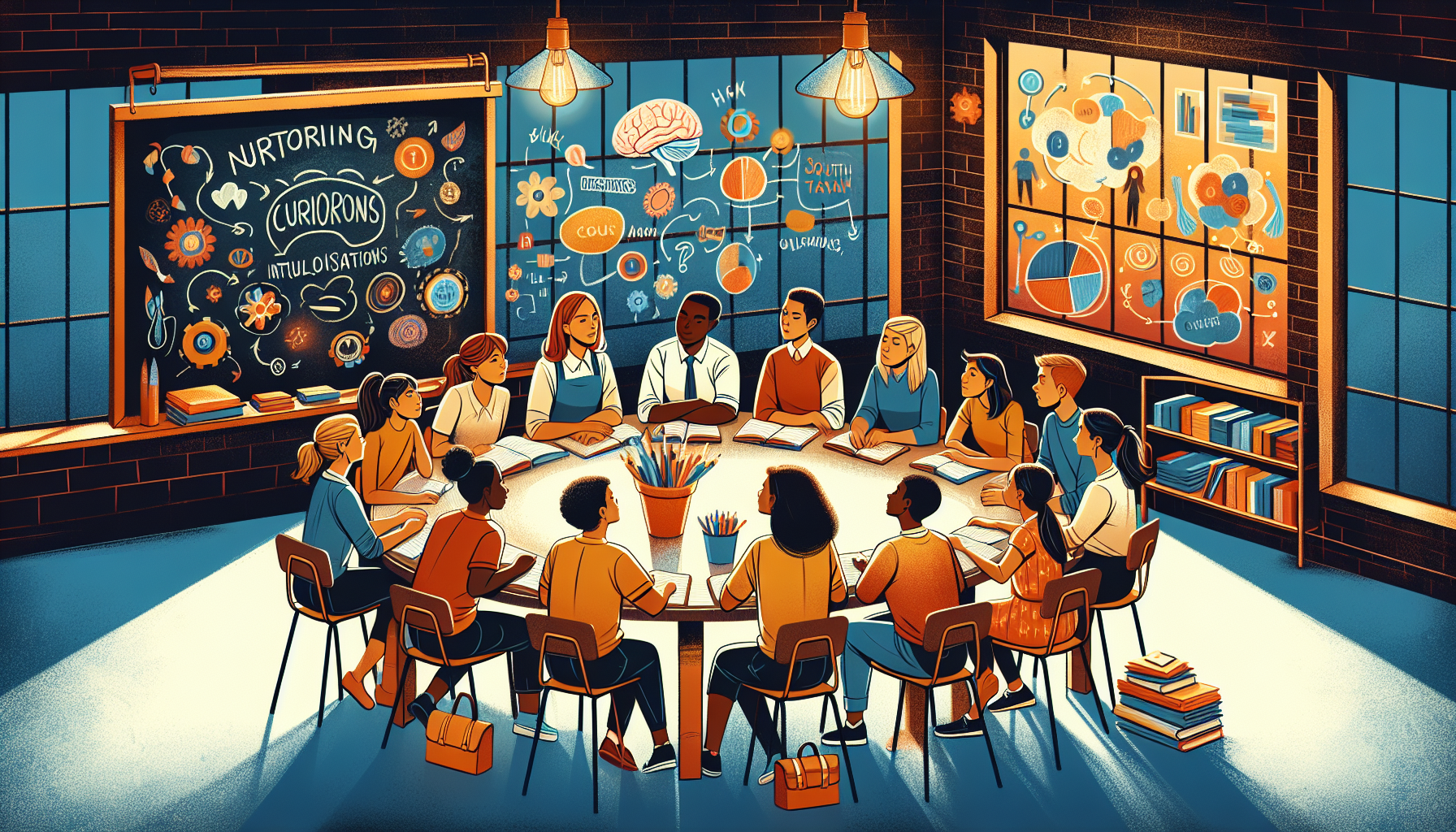Teaching critical thinking skills can seem daunting, right? It feels like a tall order when we’re bombarded with information and everyone has their own opinion. How do we sift through the noise and help others develop strong, independent thinking skills?
But here’s the good news: if you stick with me, we’ll explore some straightforward and engaging ways to teach critical thinking—all while having fun along the way! You’ll find practical strategies that make it easier for anyone to grasp the art of thinking critically.
We’ll dive into various methods, from using real-world examples to fostering curiosity and creativity in learning. By the end, you’ll have a toolbox full of ideas to spark those brilliant discussions and problem-solving sessions!
Key Takeaways
Stefan’s Audio Takeaway
- Teach critical thinking using relevant topics that connect with students’ lives.
- Use real-world examples and local issues to make lessons engaging and relatable.
- Provide clear learning objectives to guide and manage student expectations effectively.
- Cultivate curiosity by encouraging open-ended questions and discussions.
- Develop decision-making skills through practical scenarios and group discussions.
- Include diverse perspectives in learning to enhance analytical abilities.
- Implement project-based learning for hands-on experiences and teamwork.
- Promote reflective writing and peer feedback to strengthen critical thinking.
- Clarify concepts and address personal biases to foster informed analysis.
- Encourage creativity with brainstorming sessions to generate innovative ideas.
- Remain consistent and committed to teaching critical thinking throughout the year.

1. Teach Critical Thinking Skills Through Relevant Topics
It’s crucial to engage students with topics that resonate with their lives and experiences. Begin by incorporating current events or popular culture into discussions, making them feel more connected to the material.
Ask students to share their perspectives on these topics, fostering a classroom environment where diverse viewpoints are encouraged.
Encourage critical debates on these subjects to sharpen their analytical skills and help them understand the complexities of real-world issues.
2. Use Real-World Examples and Local Connections
Nothing brings theory to life like real-world application. Use case studies or examples from local communities to illustrate core concepts in your lessons.
For instance, if discussing environmental science, explore local conservation efforts or issues affecting the community.
This approach not only builds critical thinking but also helps students see the impact of their learning, making them more likely to be engaged.
Encourage students to research and share local stories that connect with the course content, enriching the class experience.
3. Provide Clear Instructions and Set Learning Objectives
Starting with clear goals can make a world of difference for your students. You should outline what students will learn by the end of a lesson or unit.
Use straightforward and understandable language when conveying these objectives, as clarity prevents confusion.
Break down complex tasks into smaller, manageable steps so students can easily follow along.
Consider creating visual aids, like checklists or flowcharts, to help students keep track of their progress and understand the expectations.

4. Cultivate Curiosity and Encourage Questions
Curiosity is the fuel for critical thinking. Create a classroom environment that not only accepts questions but celebrates them.
Encourage students to ask open-ended questions about the material. This approach will prompt deeper exploration and foster a more engaged learning atmosphere.
Consider using techniques like think-pair-share, where students discuss their questions with a partner before sharing with the class. This builds confidence and promotes collaboration.
To further stimulate curiosity, throw in intriguing facts or pose challenging dilemmas relevant to the lesson.
By fostering a questioning mindset, you help students become more engaged and analytical, preparing them for real-world challenges.
5. Foster Decision-Making and Problem-Solving Skills
Critical thinking is closely tied to decision-making. Equip your students with frameworks for making informed choices.
Introduce scenarios where they must evaluate different options and outcomes. This helps them apply critical thinking in a practical context.
Encourage group discussions where students must come to a consensus on a solution to a problem. This builds teamwork and critical reasoning skills.
Additionally, you can integrate tools like decision trees to help visualize the outcomes of choices they make.
By developing these skills, you prepare students not just to think critically but to act decisively in uncertain environments.
6. Include Diverse Perspectives in Learning
Championing diversity enriches the learning experience and sharpens critical thinking. Encourage students to express their views and listen to others.
Use materials from various cultures, backgrounds, and experiences to illustrate your lessons. This broadens students’ understanding of the world.
Organize debates or discussions that require students to argue from perspectives different from their own. This challenges their assumptions and hones their analytical abilities.
Bringing in guest speakers or experts from various fields can provide unique insights and stimulate student engagement.
As students interact with diverse opinions, they develop empathy and broader analytical skills, essential for navigating today’s globalized world.
7. Implement Project-Based Learning and Group Activities
Project-based learning allows students to tackle real-world problems, boosting their critical thinking skills significantly.
Design projects that require students to research, plan, and execute a task collaboratively. This offers hands-on experiences that make learning stick.
Group activities can encompass anything from science experiments to community service projects, fostering teamwork and critical analysis.
Encourage students to reflect on their processes and outcomes during presentations, integrating lessons learned into their future endeavors.
By engaging in this active learning method, students not only master content but also learn to think critically about issues impacting their lives.
8. Promote Critical Writing and Reflective Practices
Writing isn’t just about learning facts; it’s a powerful tool for critical thinking. Encourage your students to express their thoughts clearly and critically.
Incorporate assignments that ask them to analyze readings, synthesize information, and formulate their arguments.
Encourage reflective practices such as journaling, where students can process their learning and develop their own viewpoints. This helps them internalize concepts.
Have them peer-review each other’s work, offering insights and constructive criticism. This builds a community of learning and teaches students to evaluate critically.
By honing their writing and reflective skills, students enhance their overall ability to think critically and communicate effectively.
9. Clarify Concepts and Address Personal Biases
To think critically, students must first understand the concepts at hand. Start each lesson by clearly defining key ideas.
Utilize diagrams and real-life examples to help clarify complex topics. Pain points become “aha!” moments when concepts slip into place.
Confronting biases is equally important. Encourage students to identify their own biases and understand how these affect their thinking.
Incorporate discussions that focus on debunking common misconceptions related to the subject matter. This cultivates a more informed, balanced viewpoint.
As students clarify these concepts, they build a strong foundation for critical analysis.
10. Inspire Creativity Through Brainstorming Activities
Creativity fuels critical thinking, so incorporate brainstorming sessions into your lessons. These can produce incredible insights and ideas.
Use techniques like mind mapping or the “6-3-5” method, where six people generate three ideas each in five minutes.
Make sure to create a judgment-free environment where all ideas are welcomed. This encourages students to think outside the box without the fear of being wrong.
Allow students to work in teams to enhance their idea generation and problem-solving skills collaboratively.
Fostering creativity leads not only to innovative solutions but also strengthens their ability to think critically about diverse subjects.
11. Maintain Consistency and Commitment to Teaching Critical Thinking
Teaching critical thinking isn’t a one-time event; it’s a commitment that should be integrated consistently into your lessons.
Regularly assess your approach and be adaptable based on student feedback and engagement levels.
Set aside time each week to focus specifically on developing critical thinking skills, whether through discussion, writing assignments, or problem-solving activities.
Celebrating small successes in improving critical thinking among students can boost their confidence and motivation.
With ongoing effort, your commitment will help students build a robust toolkit for critical thinking that extends beyond the classroom and into their professional lives.
FAQs
Critical thinking skills involve the ability to analyze information, evaluate evidence, and make reasoned conclusions. These skills are essential for problem-solving and effective decision-making in various real-life situations.
Using real-world examples makes lessons relatable and engaging, helping students understand theoretical concepts by connecting them to practical applications, enhancing learning retention and critical thinking.
Curiosity drives students to ask questions, explore new ideas, and seek deeper understanding, fostering an environment that nurtures critical thinking, creativity, and engagement in the learning process.
Project-based learning allows students to tackle real problems collaboratively, requiring them to make decisions, analyze outcomes, and refine solutions, thereby enhancing their decision-making skills through active participation.
